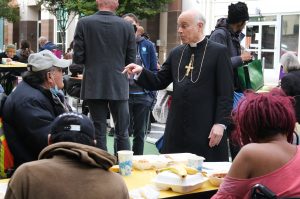Archbishop Salvatore J. Cordileone brought together San Francisco's faith, civic and social service communities at St. Mary's Cathedral for a special Mass he commissioned to pray for the souls of homeless people who died on the city's streets.
The "Requiem Mass for the Homeless" Nov. 6 featured the sacred music of Frank La Rocca, composer-in-residence of the Benedict XVI Institute for Sacred Music and Divine Worship in San Francisco.
The Mass was part of the "Year for the Homeless" launched in February by the institute and supported by the archdiocese. The yearlong observance has included calling people to prayer and fundraising activities on behalf of the homeless.
The Mass, the archbishop said, was an "act of mercy and devotion."
The grandeur of the cathedral, together with the written-for-the-occasion music was, he said, an appropriate way to "accompany our beloved deceased homeless on their way to heaven."
"Beauty is called for, for beauty has the power to heal, unite and manifest the presence of God," he said, and dignifies the human condition. "Those that are suffering the consequence of homelessness, poverty and marginalization deserve nothing less."
Seven priests joined the archbishop on the altar at the Mass, including Franciscan Father David Gaa, provincial minister of the Franciscan Friars of the Santa Barbara province.
Father Gaa oversees Franciscan ministry at St. Boniface Parish in the city's Tenderloin neighborhood and at the St. Anthony Foundation that serves it.
In his homily, Archbishop Cordileone said people without a permanent home remind society that all people are on a pilgrimage to their home with God.
"This not our true home. We are moving toward our final destiny our permanent home, which lies beyond this home," he said.
The archbishop also described St. Francis of Assisi's conversion of heart.
Having grown up in wealth, Francis was "especially repulsed" by lepers until the day he encountered a man suffering a particularly acute case, he said. The saint was moved to dismount his horse to offer him alms, and when the man stretched out his hand to receive it, St. Francis kissed it.

"Francis discovered that the object of his fear was not a monster, but a man," the archbishop said, and the saint spent the rest of his life in service to the poor and marginalized.
St. Francis was not an activist in the modern way, Archbishop Cordileone explained. He didn't rail at the social conventions that separated lepers from non-lepers and instead, he recognized their humanity, he said.
"He embraced them, kissed them, looked them in the eye," he said, an acknowledgment that they were first and foremost "children of God."
The archbishop referenced the often-quoted Gospel passage Matthew 25:31-46, where Jesus talks to his followers about their judgment before God, citing in particular the passage: "Truly I tell you, whatever you did for one of the least of these brothers and sisters of mine, you did for me."
Archbishop Cordileone distinguished between giving to get something in return, and giving out of love.
"Give to give," he said. "This is where we find our Lord hiding. Hiding in the humanity of those who are suffering, who others find repulsive."
Jesus has a proclivity for "hiding" behind the appearance of something "simple and humble," the archbishop said.
"He does that on the street, and he also does that from the altar, hiding behind a simple piece of bread and a humble cup of wine," he said.
The archbishop compared homeless people to all of humanity in speaking of the meaning of the word "tabernacle," defined literally as a tent, or a temporary shelter.
"The tent is something that has made itself very familiar to us recently even to us city dwellers," he said. As a "makeshift dwelling, that signals impermanence and instability" it's a reminder to us "how transitory life in this world is."
The institute's choir, led by principal conductor Richard Sparks, sang the music during the Mass. Christoph Tietze, the cathedral's music director, accompanied the choir on the cathedral's Ruffatti organ with a moving backdrop of violas, cellos, double bass and harp.
The Mass also introduced a painting commissioned by the archbishop, titled "Patron Saints of the Homeless."
Set up as a shrine in the sanctuary, the painting by Bernadette Carstensen acknowledges the special ministry to poor and marginalized people of St. Teresa of Kolkata, St. Anthony of Padua, St. Josephine Bakhita, St. Maximilian Kolbe, St. Benedict Labre and St. Francis of Assisi.
A printed keepsake of the work was offered to the several hundred people in attendance at the Mass. On the back was a "Litany to the Patron Saints of the Homeless," written by the Benedict XVI Institute's poet-in-residence, James Matthew Wilson.

